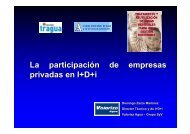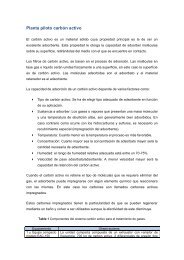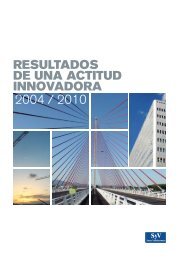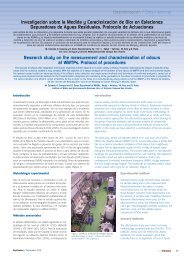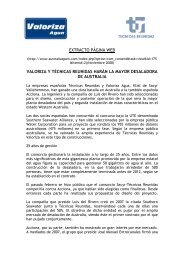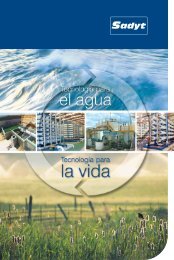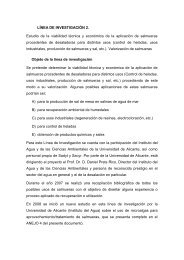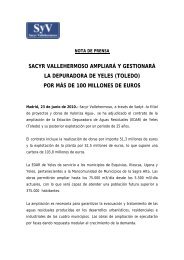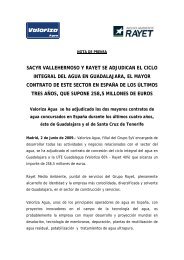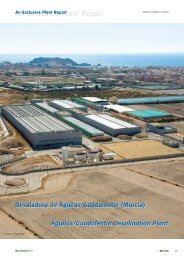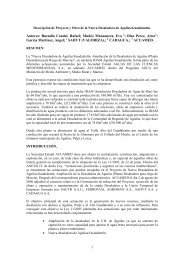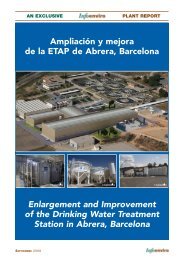Spanish experience in desalination for agriculture - Valoriza Agua
Spanish experience in desalination for agriculture - Valoriza Agua
Spanish experience in desalination for agriculture - Valoriza Agua
- No tags were found...
Create successful ePaper yourself
Turn your PDF publications into a flip-book with our unique Google optimized e-Paper software.
This article was downloaded by: [Dom<strong>in</strong>go Zarzo]On: 18 July 2012, At: 23:54Publisher: Taylor & FrancisIn<strong>for</strong>ma Ltd Registered <strong>in</strong> England and Wales Registered Number: 1072954 Registered office: Mortimer House,37-41 Mortimer Street, London W1T 3JH, UKDesal<strong>in</strong>ation and Water TreatmentPublication details, <strong>in</strong>clud<strong>in</strong>g <strong>in</strong>structions <strong>for</strong> authors and subscription <strong>in</strong><strong>for</strong>mation:http://www.tandfonl<strong>in</strong>e.com/loi/tdwt20<strong>Spanish</strong> <strong>experience</strong> <strong>in</strong> desal<strong>in</strong>ation <strong>for</strong> <strong>agriculture</strong>Dom<strong>in</strong>go Zarzo a , Elena Campos a & Patricia Terrero aa R&D Department, <strong>Valoriza</strong> <strong>Agua</strong>, Mol<strong>in</strong>a de Segura, 8, 30007, Murcia, Spa<strong>in</strong>Version of record first published: 16 Jul 2012To cite this article: Dom<strong>in</strong>go Zarzo, Elena Campos & Patricia Terrero (2012): <strong>Spanish</strong> <strong>experience</strong> <strong>in</strong> desal<strong>in</strong>ation <strong>for</strong><strong>agriculture</strong>, Desal<strong>in</strong>ation and Water Treatment, DOI:10.1080/19443994.2012.708155To l<strong>in</strong>k to this article: http://dx.doi.org/10.1080/19443994.2012.708155PLEASE SCROLL DOWN FOR ARTICLEFull terms and conditions of use: http://www.tandfonl<strong>in</strong>e.com/page/terms-and-conditionsThis article may be used <strong>for</strong> research, teach<strong>in</strong>g, and private study purposes. Any substantial or systematicreproduction, redistribution, resell<strong>in</strong>g, loan, sub-licens<strong>in</strong>g, systematic supply, or distribution <strong>in</strong> any <strong>for</strong>m toanyone is expressly <strong>for</strong>bidden.The publisher does not give any warranty express or implied or make any representation that the contentswill be complete or accurate or up to date. The accuracy of any <strong>in</strong>structions, <strong>for</strong>mulae, and drug doses shouldbe <strong>in</strong>dependently verified with primary sources. The publisher shall not be liable <strong>for</strong> any loss, actions, claims,proceed<strong>in</strong>gs, demand, or costs or damages whatsoever or howsoever caused aris<strong>in</strong>g directly or <strong>in</strong>directly <strong>in</strong>connection with or aris<strong>in</strong>g out of the use of this material.
Desal<strong>in</strong>ation and Water Treatmentwww.deswater.comiFirst (2012) 1–141944-3994/1944-3986 Ó 2012 Desal<strong>in</strong>ation Publications. All rights reserveddoi: 10.1080/19443994.2012.708155<strong>Spanish</strong> <strong>experience</strong> <strong>in</strong> desal<strong>in</strong>ation <strong>for</strong> <strong>agriculture</strong>Dom<strong>in</strong>go Zarzo*, Elena Campos, Patricia TerreroR&D Department, <strong>Valoriza</strong> <strong>Agua</strong>, Mol<strong>in</strong>a de Segura, 8, 30007 Murcia, Spa<strong>in</strong>Email: dzarzo@gruposyv.comReceived 28 February 2012; Accepted 27 June 2012Downloaded by [Dom<strong>in</strong>go Zarzo] at 23:54 18 July 2012A B S T R A C TDesal<strong>in</strong>ation <strong>in</strong> Spa<strong>in</strong> has a long story. From the early 60s many <strong>in</strong>stallations <strong>for</strong> dr<strong>in</strong>k<strong>in</strong>gwater supply were built, ma<strong>in</strong>ly <strong>in</strong> the Canary Islands. Soon it was assumed that other userswould need water supply at competitive prices. Agriculture was one of them. The leap fromthe islands to ma<strong>in</strong>land was <strong>in</strong> the 90s, when there was a substantial water shortage. In thisdecade, more than 200 <strong>in</strong>stallations were built <strong>for</strong> this application, ma<strong>in</strong>ly treat<strong>in</strong>g brackishwater. More recently, the <strong>in</strong>stallation of large capacity plants from <strong>Spanish</strong> government programme“AGUA” would mean the end of small plants <strong>for</strong> <strong>agriculture</strong> although a discussionabout the price <strong>for</strong> desal<strong>in</strong>ated water arose between the government and the agriculturalusers. In this paper, we will describe the <strong>Spanish</strong> <strong>experience</strong> <strong>in</strong> desal<strong>in</strong>ation <strong>for</strong> <strong>agriculture</strong>from an historic po<strong>in</strong>t of view. We will also discuss the economic aspects such as the priceof water obta<strong>in</strong>ed from desal<strong>in</strong>ation plants compared with other sources such as superficialor reused water as well as the percentage of water costs <strong>in</strong> <strong>agriculture</strong> production and otherbeneficial aspects such as <strong>in</strong>creased production. With the <strong>experience</strong> ga<strong>in</strong>ed <strong>for</strong> more than17 years and 60 different size <strong>in</strong>stallations built, this paper will be illustrated with someexamples where farmers have built their own desal<strong>in</strong>ation plants. Another <strong>in</strong>terest<strong>in</strong>g aspectwill be to show how to do the plann<strong>in</strong>g <strong>for</strong> an irrigation system <strong>for</strong> <strong>agriculture</strong> based ondesal<strong>in</strong>ation.Keywords: Agriculture; Desal<strong>in</strong>ation; Irrigation1. IntroductionDesal<strong>in</strong>ation <strong>for</strong> <strong>agriculture</strong> is reported all over theworld and ma<strong>in</strong>ly <strong>in</strong> Mediterranean countries. Thenecessity <strong>for</strong> a safe, reliable and local food supply isbecom<strong>in</strong>g lately a strategic necessity and priority, andthe use of a safe source of water with quality and acompetitive price, makes desal<strong>in</strong>ation an <strong>in</strong>creas<strong>in</strong>glyfrequent option.*Correspond<strong>in</strong>g author.The use of water <strong>for</strong> <strong>agriculture</strong> represents 70% ofthe global use of water and <strong>in</strong> develop<strong>in</strong>g countriesthe consumption of water <strong>in</strong> the agricultural sectorexceeds 80% [1]. This gives us an idea about the magnitudeof the problem of water supply <strong>for</strong> this application.Many people th<strong>in</strong>k that this application is not feasibledue to the high water costs, but the reality is thatit has been used <strong>in</strong> many countries with success <strong>for</strong>years. If we analyze the data provided by the InternationalDesal<strong>in</strong>ation Association [2], currently there arearound 66.4 million m 3 /day <strong>in</strong>stalled <strong>in</strong> desal<strong>in</strong>ationPresented at the International Conference on Desal<strong>in</strong>ation <strong>for</strong> the Environment, Clean Water and Energy, European Desal<strong>in</strong>ationSociety, 23–26 April 2012, Barcelona, Spa<strong>in</strong>
2 D. Zarzo et al. / Desal<strong>in</strong>ation and Water TreatmentDownloaded by [Dom<strong>in</strong>go Zarzo] at 23:54 18 July 2012plants all over the world and only 1.9% is used <strong>in</strong><strong>agriculture</strong> (although other sources [3] supplied avalue around 3%). However, this data cannot be analyzedso easily because evaporation technologiesaccount <strong>for</strong> 35% of the total <strong>in</strong>stalled capacity (andobviously it is difficult if not impossible to use thiswater <strong>for</strong> irrigation because of its high cost), and thereare countries where this percentage is much higher.For example <strong>in</strong> Spa<strong>in</strong>, more than 22% of the desal<strong>in</strong>ationcapacity is used <strong>for</strong> agricultural irrigation [4] and<strong>in</strong> some regions is even more.With<strong>in</strong> this framework, it must be emphasized thatit is necessary to carry out feasibility studies of thetechnology <strong>in</strong> different countries and its potential <strong>for</strong>expansion, promot<strong>in</strong>g safe and local food production,and consider<strong>in</strong>g factors such as weather or droughtperiods.Seventy-five percent of Spa<strong>in</strong>’s water demandscomes from <strong>agriculture</strong> and irrigation (<strong>in</strong> areas suchas Almeria it can be more then 90%), which expla<strong>in</strong>sthe search of alternative water sources. We must take<strong>in</strong>to account that the high added-value <strong>agriculture</strong>takes place <strong>in</strong> the Mediterranean area, be<strong>in</strong>g preciselythe region with water scarcity problems. Reuse isanother important non-conventional water source, represent<strong>in</strong>garound 13% of total treated wastewater (atnational level), although <strong>in</strong> the Mediterranean regionthis value is <strong>in</strong>creased to 75–90%, depend<strong>in</strong>g on thearea.<strong>Spanish</strong> <strong>agriculture</strong> has to deal with a limitedavailability of water with an irregular regime of precipitation(drought, decoupl<strong>in</strong>g of the annual regimewith schedules of irrigation, torrential phenomena,etc.) and recurrent droughts. Recent data (February2012) from the <strong>Spanish</strong> Drought Observatory confirmthe beg<strong>in</strong>n<strong>in</strong>g of a drought period <strong>in</strong> Spa<strong>in</strong>; the lastquarter has been the most dry period <strong>in</strong> the last50 years with a reduction of around 40% of thenational average ra<strong>in</strong>fall <strong>for</strong> the season.In such conditions, to have a sufficient quantity ofwater becomes a strategic element to ensure the viabilityof many farms. However, it is reported [5] thatwater consumption <strong>in</strong> <strong>agriculture</strong> grew up twice morerapidly than total consumption of water <strong>in</strong> the economyas a whole <strong>in</strong> Spa<strong>in</strong> from 1990–1992 to 2001–2003. Much of this <strong>in</strong>crease is due to the 8% <strong>in</strong>creaseof irrigated land <strong>in</strong> that period, represent<strong>in</strong>g morethan a quarter of the total area irrigated <strong>in</strong> the EU15<strong>in</strong> 2001–2003.The ma<strong>in</strong> problem arises from the fact that <strong>in</strong> ourcountry <strong>in</strong> general, the most fertile and productiveareas <strong>for</strong> <strong>agriculture</strong> are <strong>in</strong> the regions with less availabilityof water resources. This situation is more serious<strong>in</strong> the <strong>Spanish</strong> Southeast, <strong>in</strong> prov<strong>in</strong>ces such asAlmeria and Murcia where the agricultural <strong>in</strong>dustry isone of the ma<strong>in</strong> economic pillars. In Almeria, <strong>for</strong>example, <strong>agriculture</strong> represents nearly 20% of theeconomy, whereas <strong>in</strong> Spa<strong>in</strong> the overall contribution isaround 5%.Regard<strong>in</strong>g the orig<strong>in</strong> of water <strong>for</strong> <strong>agriculture</strong> application<strong>in</strong> Spa<strong>in</strong>, a reference from 2009 [6] po<strong>in</strong>ts outthat 78.6% is from superficial water, 20.4% fromgroundwater and only 1% is from non-conventionalresources (desal<strong>in</strong>ation and reuse). Once more wehave to po<strong>in</strong>t out that data are at national level and <strong>in</strong>certa<strong>in</strong> regions the percentage of desal<strong>in</strong>ated water issignificantly higher.2. Peculiarities of desal<strong>in</strong>ation <strong>for</strong> <strong>agriculture</strong>:differences with other applications2.1. Differential aspectsDesal<strong>in</strong>ation plants <strong>for</strong> <strong>agriculture</strong> <strong>in</strong> general havesome differential aspects to consider <strong>in</strong> comparisonwith other desal<strong>in</strong>ation plants (dr<strong>in</strong>k<strong>in</strong>g water and<strong>in</strong>dustrial). Some of them are:• Limited requirements of personnel, chemicals andmembrane replacement (due to the lower waterquality required) which means reduced costs.• Ability to regulate water production accord<strong>in</strong>g toelectrical tariffs <strong>in</strong> order to produce water at lowerenergy cost (<strong>in</strong> general this is particularly true <strong>for</strong>brackish water plants with big storage ponds).• Lower requirements with respect to product watersal<strong>in</strong>ity and post-treatment, leav<strong>in</strong>g out specificproblems with boron or other crop toxics.• Simplicity; reduced requirements <strong>for</strong> civil works,automation and safety measures to guarantee production.2.2. Water qualityThere are numerous standards <strong>for</strong> the qualificationof water depend<strong>in</strong>g on its possible use <strong>for</strong> irrigation.Among them are standards Riverside, H. Greene, L.V.Wilcox, etc. which qualify the water accord<strong>in</strong>g to severalparameters, be<strong>in</strong>g basically relationships betweenconductivity and concentration of sodium and otherions. These standards are related with the effects ofwater over the soils and modification of soil structure.Depend<strong>in</strong>g on the type of crops and the characteristicsof the soil (permeability, dra<strong>in</strong>age, etc.) it couldbe necessary <strong>for</strong> different quantity and quality ofwater <strong>for</strong> the irrigation, which will have an importantrole <strong>in</strong> design<strong>in</strong>g the desal<strong>in</strong>ation plant.
D. Zarzo et al. / Desal<strong>in</strong>ation and Water Treatment 3Downloaded by [Dom<strong>in</strong>go Zarzo] at 23:54 18 July 20122.2.1. Rem<strong>in</strong>eralizationPermeate from reverse osmosis (RO) plants has areduced level of calcium and magnesium as well as aslightly acid pH. This could cause damages <strong>in</strong> the soilstructure <strong>for</strong> which it is recommendable to rem<strong>in</strong>eralize<strong>in</strong> order to adjust the relationship betweensodium, calcium and magnesium.There are desal<strong>in</strong>ation plants <strong>for</strong> <strong>agriculture</strong> withconventional rem<strong>in</strong>eralization systems (lime dos<strong>in</strong>g orcalcite/dolomite filters), but the most common rem<strong>in</strong>eralizationsystem <strong>for</strong> <strong>agriculture</strong> water is the blend<strong>in</strong>gwith water from other orig<strong>in</strong>s (superficial orground water), reduc<strong>in</strong>g <strong>in</strong> this way the overall costof product water. In any case the cost of post-treatmentis virtually negligible vs. desal<strong>in</strong>ation cost itself.In Spa<strong>in</strong>, there are some <strong>in</strong>terest<strong>in</strong>g studies done bythe Fundacion Centro Canario del <strong>Agua</strong> <strong>in</strong> the CanaryIslands about the rem<strong>in</strong>eralization of desal<strong>in</strong>ated water(<strong>in</strong>clud<strong>in</strong>g the research and design of rem<strong>in</strong>eralizationsystems and even a good practices manual) and specifically<strong>for</strong> <strong>agriculture</strong> described <strong>in</strong> many papers andworks from this organization (www.fcca.es).2.2.2. BoronOne of the ma<strong>in</strong> current problems when we speakabout desal<strong>in</strong>ation <strong>for</strong> <strong>agriculture</strong> is the toxicity ofboron <strong>for</strong> different crops and the high boron membranepassage. This is especially problematic <strong>for</strong> seawaterand the reason why <strong>in</strong> many plants a secondpass RO is required.There are some classifications regard<strong>in</strong>g toleranceof boron by crops depend<strong>in</strong>g on the concentration ofboron <strong>in</strong> water, such as the follow<strong>in</strong>g [7]:(a)(b)(c)Sensitive crops (0.30–1.0 mg/l): Apple, cherry,lemon, oranges, peach, grapefruit, avocado, elmtree, apricot tree, fig, grapes, plum and beans.Semi-tolerant crops (1.0–2.05 mg/l): barley, cabbage,carrot, lettuce, onion, potato, pumpk<strong>in</strong>,sp<strong>in</strong>ach, tobacco, olive, roses, tomato andwheat.Tolerant crops (2.05–4.0 mg/l): asparagus, cranberry,cotton, cucumber, gladiolus, Sesame,tulip, beet, bean, grass, pepperm<strong>in</strong>t and rye.Italso seems that this toxicity is more related tothe rate or velocity of accumulation of boron <strong>in</strong>the plant than <strong>in</strong> its toxicity itself.In our <strong>experience</strong> deal<strong>in</strong>g with the agricultural sector,we have seen the effects of boron ma<strong>in</strong>ly on orangesand lemons, with a reduction of production, leaveswhiten<strong>in</strong>g, etc. This happened when crops were irrigatedwith brackish water with poor quality and levelsof 2–3 mg/l of boron or even more. When crops beganto be irrigated with desal<strong>in</strong>ated water (ma<strong>in</strong>ly frombrackish water from wells), the effects disappeared.The concentration of boron <strong>in</strong> groundwater variessignificantly depend<strong>in</strong>g on the area. In general, <strong>in</strong>South Europe (Italy, Spa<strong>in</strong>) the concentration is usuallybetween 0.5 and 1.5 mg/l, be<strong>in</strong>g lower <strong>in</strong> theNorth of the cont<strong>in</strong>ent. It is <strong>in</strong>terest<strong>in</strong>g to note thatmost of the concentration of boron <strong>in</strong> the planet is <strong>in</strong>the oceans, with a range <strong>in</strong> seawater which normallyfluctuates between 4 and 6 mg/l.The situation varies <strong>in</strong> different countries. InSpa<strong>in</strong>, <strong>for</strong> example, the requirement from the newdesal<strong>in</strong>ation plants from the AGUA programme was0.5 mg/l of boron <strong>in</strong> product water, which was clearlya requirement from the <strong>agriculture</strong> sector because thedr<strong>in</strong>k<strong>in</strong>g water standard <strong>in</strong> Spa<strong>in</strong> and <strong>in</strong> EuropeanUnion (EU) countries is 1 mg/l. Another differentexample could be the requirement of 0.3 mg/l ofboron <strong>in</strong> many plants <strong>in</strong> Israel.Currently the technologies used <strong>for</strong> boron reductionare a partial second RO pass or an ion exchangeres<strong>in</strong>, comb<strong>in</strong>ed with pH <strong>in</strong>crease, which <strong>in</strong>creases thecapital expenditure and operational expense of thedesal<strong>in</strong>ation plants.3. Advantages and disadvantages of the desal<strong>in</strong>ation<strong>for</strong> <strong>agriculture</strong>The ma<strong>in</strong> benefits of the use of desal<strong>in</strong>ated water<strong>for</strong> <strong>agriculture</strong> are:• Non-conventional and additional water resource;• <strong>in</strong> the case of seawater, <strong>in</strong>exhaustible resource notdepend<strong>in</strong>g on the weather;• <strong>in</strong>crease <strong>in</strong> productivity and quality of <strong>agriculture</strong>products;• less water consumption and• recovery of salty soils.In an unpublished study done by the authors someyears ago, it was observed that later to the irrigation ofa field of citric fruits with desal<strong>in</strong>ated water (previouslythe water supply was from wells with 5–7 mS/cm orsuperficial water with 1.2–2.2 mS/cm or blend<strong>in</strong>g ofboth), when desal<strong>in</strong>ated water was used the production<strong>in</strong>creased around 10% from the superficial water andmore than 50% from the brackish well water, withreduced water needs by 20%. Although this is an oldstudy, the current situation could be similar.If we consider the economic benefits, the results arequite a bit better (although the supplied data are fromsome years ago, the comparison cont<strong>in</strong>ues be<strong>in</strong>g good):
4 D. Zarzo et al. / Desal<strong>in</strong>ation and Water TreatmentDownloaded by [Dom<strong>in</strong>go Zarzo] at 23:54 18 July 2012The study was done <strong>in</strong> a 40 hectare farm, with 417trees per hectare and drip irrigation, with a crop varietyNavel Late (oranges) (Table 1).In similar <strong>experience</strong>s carried out <strong>in</strong> CanaryIslands with banana <strong>in</strong> greenhouses irrigated withdesal<strong>in</strong>ated wastewater, the necessary quantity of fertilizerswas reduced by half, the water needs werereduced by 30% and the production also <strong>in</strong>creased,and the maturation was earlier [8].There are some published studies about the impactof water quality <strong>in</strong> productivity. For example isreported [9] that <strong>for</strong> a selection of products (<strong>in</strong>clud<strong>in</strong>galmond, orange, pepper, lettuce, cucumber, tomato,broccoli and celery), the optimum sal<strong>in</strong>ity <strong>in</strong> water <strong>for</strong>irrigation was below 2 mS/cm. From this po<strong>in</strong>t any<strong>in</strong>crease <strong>in</strong> sal<strong>in</strong>ity produced a reduction <strong>in</strong> productivity,be<strong>in</strong>g remarkable that almond (the most sensitive)followed by orange, pepper and lettuce, got a productionclose to zero with sal<strong>in</strong>ities between 4.5 and6 mS/cm. In this case celery was the least sensitivecrop with a reduction close to 50% at around 6.5 mS/cm and close to zero at 12 mS/cm.The production of crops is also dependent on thevolume of water used <strong>for</strong> irrigation, and this has twodifferent and conflict<strong>in</strong>g effects; higher volume ofdesal<strong>in</strong>ated water implies more cost, but if there is notenough quantity of water, the use of desal<strong>in</strong>atedwater will <strong>in</strong>crease the productivity.Another <strong>in</strong>terest<strong>in</strong>g positive f<strong>in</strong>d<strong>in</strong>g is that thelarge number of plants <strong>in</strong>stalled <strong>for</strong> <strong>agriculture</strong> <strong>in</strong>Spa<strong>in</strong> <strong>in</strong> the last decades have enabled the water companiesto acquire a great <strong>experience</strong> <strong>in</strong> the sector deal<strong>in</strong>gwith very different types of water. These plantshave <strong>in</strong>corporated new technological advances evenbe<strong>for</strong>e the public utilities e.g. energy recovery devicesboth <strong>for</strong> brackish and seawater, test<strong>in</strong>g of new membranes,etc. always with the aim of reduc<strong>in</strong>g costswith an <strong>in</strong>novative spirit.On the other hand, desal<strong>in</strong>ation <strong>for</strong> this applicationhas other disadvantages:• Higher water costs (depend<strong>in</strong>g on the source) noteconomically susta<strong>in</strong>able by some products or <strong>in</strong>certa<strong>in</strong> areas (<strong>in</strong>land).• Water has to be ionically balanced (SAR (sodiumadsorption rate) and other <strong>in</strong>dexes).• High quality requirements from the po<strong>in</strong>t of viewof some toxics (such as boron).• Possible exhaustion of aquifers <strong>in</strong> the case ofground water desal<strong>in</strong>ation.• In the case of brackish water, the additional problemof br<strong>in</strong>e management and discharge withoutan economically feasible solution <strong>in</strong>land.Regard<strong>in</strong>g the groundwater, a report from theOCDE [5] <strong>in</strong>dicates that a generalized overexploitationof aquifers take place <strong>in</strong> the Mediterranean coast ofSpa<strong>in</strong>. Around a 13% of the irrigated land <strong>in</strong> this areais supplied from exhausted aquifers or with sal<strong>in</strong>izationrisk.It is remarkable that <strong>in</strong> Campo de Cartagena <strong>in</strong>Murcia (the ma<strong>in</strong> po<strong>in</strong>t of concentration of desal<strong>in</strong>ationplants <strong>for</strong> <strong>agriculture</strong> <strong>in</strong> Spa<strong>in</strong>), the <strong>Spanish</strong> EnvironmentM<strong>in</strong>istry built <strong>in</strong> 1997 a pipe network <strong>for</strong>collect<strong>in</strong>g the br<strong>in</strong>es from desal<strong>in</strong>ation plants (manyof them illegal at this time) <strong>in</strong> order to avoid dischargesto a protected area (Mar Menor, a smalllagoon with seawater connected to the MediterraneanSea). Br<strong>in</strong>es together with water from agriculturaldra<strong>in</strong>ages were sent to a new desal<strong>in</strong>ation plant capableof treat<strong>in</strong>g that water to br<strong>in</strong>g it back, oncedesalted, to the irrigation distribution channels. Somedata about this plant are shown <strong>in</strong> Table 8, column 3(Drenajes). A similar <strong>experience</strong> was tried <strong>in</strong> the Southof Alicante but with less success and even a plantwith deep-well <strong>in</strong>jection of br<strong>in</strong>e <strong>in</strong>stalled (Jacarillabrackish water reverse osmosis [BWRO]) with this dischargewas cancelled further.About the costs, it is necessary to po<strong>in</strong>t out alsothat many problems of <strong>agriculture</strong> production arisefrom the reduction of product marg<strong>in</strong>s or benefits(even some products are be<strong>in</strong>g sold below the productioncosts, because there are products imported fromother countries with lower costs). In this case, watercost is a problem but not the key or ma<strong>in</strong> problem.Another po<strong>in</strong>t is that water can be expensivedepend<strong>in</strong>g on what we are compar<strong>in</strong>g it with. Forexample, we th<strong>in</strong>k that the common discussion aboutdesal<strong>in</strong>ation vs. reused water <strong>for</strong> <strong>agriculture</strong> is po<strong>in</strong>tlessbecause each of these technologies has its optimumapplication <strong>in</strong> function of production costs,distance to the po<strong>in</strong>t of application, required quality,etc., and of course if another water source is not available,any price will be acceptable.Regard<strong>in</strong>g the water price, another important factorto consider is the utilization rate, because whenthe plant is not operat<strong>in</strong>g the price per m 3 is <strong>in</strong>creasedto <strong>in</strong>crease the relative contribution of the fixed costs.Many of the users <strong>in</strong> the area between Alicanteand Almeria, are us<strong>in</strong>g water from the Tajo-Seguratransfer and <strong>in</strong> the last years this superficial water hasbeen the ma<strong>in</strong> supply <strong>for</strong> <strong>agriculture</strong>. Recently (18February 2012) the <strong>Spanish</strong> Council of M<strong>in</strong>istersapproved new tariffs <strong>for</strong> the utilization of the Tajo-Segura aqueduct <strong>for</strong> the current year, with a significantprice decrease based on the reduction of the costof electric energy of the last period, below their esti-
D. Zarzo et al. / Desal<strong>in</strong>ation and Water Treatment 5Table 1Comparison of economic benefits <strong>in</strong> a farm us<strong>in</strong>g water from different sourcesWater orig<strong>in</strong>Superficial (Tajo-SeguraRivers transfer)Brackish waterfrom wellsPermeate fromBWRO plantWater price (e/m 3 ) 0.1322 0.054 a 0.2284 (<strong>in</strong>clud<strong>in</strong>g payback)Incomes (fruit sales) (e/year) 15,037 7,519 b 16,539 cExpenses (e/year) 3,885 3,885 4,273Benefit (e/year) 11,152 3,634 12,268Note: economic data were supplied by the farmer, participant <strong>in</strong> the study.a With well <strong>in</strong> property.b In this case the fruit production is below 50% compared to irrigation with superficial water.c Increased <strong>in</strong>comes due to the higher production.Downloaded by [Dom<strong>in</strong>go Zarzo] at 23:54 18 July 2012mations. Accord<strong>in</strong>g to the M<strong>in</strong>istry of Agriculture,Food and Environment these rates are <strong>in</strong>tended torecover the annual costs of operation, operation andma<strong>in</strong>tenance of the aqueduct, as well as to amortizethe <strong>in</strong>vestments made by the Government. The tariffshave been reduced more than 30% this year from0.174 to 0.124 e/m 3 . On the other hand, some environmentalorganizations, such as world wide fund <strong>for</strong>nature <strong>in</strong> Spa<strong>in</strong>, have compla<strong>in</strong>ed that the calculationof the new rates <strong>for</strong> the use of the Tajo-Segura aqueductseems to have not <strong>in</strong>cluded the environmentalcosts. Really these prices are fixed by the governmentand we do not know the real cost. We must bear <strong>in</strong>m<strong>in</strong>d also that accord<strong>in</strong>g with the EU Water FrameworkDirective is mandatory the full-price waterrecovery by 2010.Anyway, water transfer between different regionsis sometimes conflictive by political and economicalreasons and it is deeply affected by the weather conditions.It is generally admitted that water costs are areduced percentage of the overall cost of crop production,around 5%, although some authors reported thatthis could range between 5 and 25%, depend<strong>in</strong>g onwater price and even more than 45% <strong>for</strong> crops with ahigh water requirement (as oranges or lemons) [10].Other <strong>in</strong>terest<strong>in</strong>g data could be the differences <strong>for</strong> thesame product (e.g. tomatoes) when we compare production<strong>in</strong> greenhouses or <strong>in</strong> an open field, as shown<strong>in</strong> Table 2 [9].Table 2Effect of water price over the overall production cost oftomatoes (expressed as <strong>in</strong>crease <strong>in</strong> % of total cost)Water price (e/m 3 ) Greenhouses (%) Open field (%)0.12 2.2 50.54 9.3 19.3Source: Ref. [9].In an <strong>in</strong>terest<strong>in</strong>g report from the <strong>Spanish</strong> M<strong>in</strong>istryof Environment [11], the economic recovery of water<strong>for</strong> agricultural products was calculated. The resultsshowed that greenhouse products (horticultural, flowersand ornamental plants) provide greater addedvalue per unit of irrigated water with 5.79 e/m 3 onaverage <strong>in</strong> Spa<strong>in</strong>. Far from these values, with <strong>in</strong>termediateproductivity are v<strong>in</strong>eyards and fruit trees (1.08and 0.68 e/m 3 , respectively). On the other hand, thecereal gra<strong>in</strong> reach an average productivity of around0.06 e/m 3 , which be<strong>in</strong>g the ma<strong>in</strong> crop <strong>in</strong> Spa<strong>in</strong>, producesan average of 0.41 e/m 3 <strong>for</strong> all the products.In a study made <strong>in</strong> 2008 [12] by the community ofusers of water <strong>in</strong> the area of Nijar, Almeria, some<strong>in</strong>terest<strong>in</strong>g data here supplied about the productivityof water <strong>in</strong> <strong>agriculture</strong> (Table 3):In this case, water consumption per hectare was5,600 m 3 , with a total consumption of 150 hm 3 andwater productivity of 11.41 e/m 3 . The water costssupplied [12] were 0.22 e/m 3 <strong>for</strong> brackish water,0.44 e/m 3 <strong>for</strong> desal<strong>in</strong>ated water and 0.33 e/m 3 <strong>for</strong>result<strong>in</strong>g blended water.Another problem to evaluate the cost of water,ma<strong>in</strong>ly from desal<strong>in</strong>ation, is the energy price. Inrecent years, it has been <strong>in</strong>creas<strong>in</strong>g very fast, and dueto this, the ma<strong>in</strong> cost <strong>in</strong> a desal<strong>in</strong>ation production, thewater costs are cont<strong>in</strong>uously <strong>in</strong>creas<strong>in</strong>g (although thisTable 3Almeria and its production under plastic. Relationshipwater-harvestCrop Type Hectares Production value (<strong>in</strong>thousands of Euros)Greenhouses 26,833 1,714,969Lettuces 4,260 90,248Extensive (not lettuces) 3,277 97,852Total 34,370 1,903,069Source: Ref. [12].
6 D. Zarzo et al. / Desal<strong>in</strong>ation and Water TreatmentDownloaded by [Dom<strong>in</strong>go Zarzo] at 23:54 18 July 2012occurs also with water from other sources whenpump<strong>in</strong>g or other energy consumers are implied).However, there are public and private <strong>in</strong>itiativesus<strong>in</strong>g desal<strong>in</strong>ation <strong>for</strong> <strong>agriculture</strong> and it is predictablethat this will cont<strong>in</strong>ue to happen <strong>in</strong> the future.4. History of desal<strong>in</strong>ation <strong>for</strong> <strong>agriculture</strong> <strong>in</strong> spa<strong>in</strong>As it is well known, Spa<strong>in</strong> has historically sufferedimportant lack of water resources that has worsenedover time, <strong>in</strong>clud<strong>in</strong>g cyclic drought periods, like thecurrent situation. These problems are more important<strong>in</strong> the most drought prone areas <strong>in</strong> Spa<strong>in</strong>, such as theSouth Mediterranean coastal areas or <strong>in</strong> the islands(Balearic and Canary Islands).The history of desal<strong>in</strong>ation <strong>in</strong> Spa<strong>in</strong> starts <strong>in</strong> the60s, and we could summarize it as follows;1964: 1st desal<strong>in</strong>ation plant <strong>in</strong> Lanzarote (CanaryIslands).70s: construction of further desal<strong>in</strong>ation plants <strong>in</strong> CanaryIslands.80s: <strong>in</strong>stallation of desal<strong>in</strong>ation plants <strong>for</strong> irrigation <strong>in</strong>Canary Islands as well as on the ma<strong>in</strong>land.90s: <strong>in</strong>stallation of desal<strong>in</strong>ation plants <strong>for</strong> irrigation onthe ma<strong>in</strong>land, due to the severe drought.1995–2000: significant growth <strong>in</strong> <strong>in</strong>stalled capacity.2000–2005: execution of large desal<strong>in</strong>ation projects.Installation of desal<strong>in</strong>ation plants treat<strong>in</strong>g wastewater.2005–2011: AGUA Programme.2012: Current situation.4.1. The beg<strong>in</strong>n<strong>in</strong>g: Canary IslandsThe Canary Islands were the place <strong>for</strong> the beg<strong>in</strong>n<strong>in</strong>gof desal<strong>in</strong>ation <strong>in</strong> Spa<strong>in</strong> and Europe. The firstplant was <strong>in</strong>stalled <strong>in</strong> Lanzarote Island <strong>in</strong> 1964 <strong>for</strong>dr<strong>in</strong>k<strong>in</strong>g water supply. The plant had 2,300 m 3 /daycapacity and the technology was MSF. This plant wasfollowed <strong>in</strong> 1969 by Las Palmas I, <strong>in</strong> Gran Canaria,with 20,000 m 3 /day capacity by MSF.In the mid-seventies, the first plant <strong>in</strong>stalled <strong>for</strong><strong>agriculture</strong> was a small plant (80 m 3 /day) <strong>in</strong> Fuerteventuraus<strong>in</strong>g brackish water. The first seawaterreverse osmosis (SWRO) plant <strong>for</strong> irrigation was built<strong>in</strong> 1987 <strong>for</strong> the company Bonny <strong>in</strong> a plant called LasSal<strong>in</strong>as, with 6,900 m 3 /day capacity expanded to500 m 3 /day further. In 1988 <strong>in</strong> los Llanos de JuanGrande (Gran Canaria) another 6,000 m 3 /day capacityplant was built <strong>for</strong> <strong>agriculture</strong> with membranes (RO).This was followed <strong>in</strong> 1989 by another plant from acooperative society called Agragua, located <strong>in</strong> Galdar,Gran Canaria, with 15,000 m 3 /day us<strong>in</strong>g hollow fibremembranes.The first large desal<strong>in</strong>ation plant by membranes(RO) was built <strong>in</strong> 1990 <strong>in</strong> Las Palmas de Gran Canaria,with a capacity of 36,000 m 3 /day which has beenexpanded successively to the current capacity of80,000 m 3 /day.There are many examples <strong>in</strong> the Canary Islandsus<strong>in</strong>g Electrodialysis Reversal (EDR) as desal<strong>in</strong>ationtechnology <strong>in</strong> 90s. Some examples are between 1,000and 2,000 m 3 /day <strong>in</strong>clud<strong>in</strong>g plants with partial use <strong>for</strong><strong>agriculture</strong>, such as ICOD 2 (2,100 m 3 /day, 2003) orTamalmo (2,100 m 3 /day, 2003) [3]. The great expansionof the use of EDR <strong>in</strong> Canary Island is due to twoma<strong>in</strong> factors: the presence of silica <strong>in</strong> undergroundwater due to the volcanic orig<strong>in</strong> of the islands and agood commercial work from the EDR suppliers.Forecasts of the Canarian Government set a productionof desal<strong>in</strong>ated water of 188.0 hm 3 <strong>for</strong> 2012[13]. The most relevant current data on desal<strong>in</strong>ationare <strong>in</strong> Table 4.It is remarkable that the high number of private <strong>in</strong>itiatives(vs. the public ones) shows the relevant use ofdesal<strong>in</strong>ation <strong>for</strong> <strong>agriculture</strong> and tourism <strong>in</strong> the region.It is <strong>in</strong>terest<strong>in</strong>g to note that <strong>in</strong> Lanzarote and Fuerteventura100% of the dr<strong>in</strong>k<strong>in</strong>g water supply is from desal<strong>in</strong>ationplants and <strong>for</strong> Gran Canaria is around 80%.Accord<strong>in</strong>g to the same report, the current cost ofwater production from seawater is 0.5–0.6 e/m 3 ,whereas if the orig<strong>in</strong> is brackish water, the price is 0.2–0.3 e/m 3 . These values are consistent with those found<strong>in</strong> the rest of Spa<strong>in</strong> and <strong>in</strong> our own <strong>experience</strong>s.Balearic Islands also have an important desal<strong>in</strong>ationcapacity, around 30 hm 3 /year, but <strong>in</strong> this case,the desal<strong>in</strong>ation plants are ma<strong>in</strong>ly public ones <strong>for</strong>dr<strong>in</strong>k<strong>in</strong>g water supply be<strong>in</strong>g the orig<strong>in</strong> of water used<strong>for</strong> <strong>agriculture</strong> ma<strong>in</strong>ly from groundwater extraction orreused water. The authors have no <strong>in</strong><strong>for</strong>mation aboutany important plant <strong>in</strong> Balearic Islands <strong>for</strong> <strong>agriculture</strong>,although there are some plants <strong>for</strong> irrigation of golfcourses.The irrigation of golf courses, although it is notexactly an <strong>agriculture</strong> application, shares many char-Table 4Relevant data on desal<strong>in</strong>ation <strong>in</strong> Canary IslandsIslandDesal<strong>in</strong>ationplantsPublic Production (m 3 /day)Tenerife 44 5 118,143Gran Canaria 137 11 336,195Fuerteventura 64 4 65,049Lanzarote 80 0 62,570La Gomera 1 0 4,100El Hierro 4 4 2,000Source: Ref. [11].
D. Zarzo et al. / Desal<strong>in</strong>ation and Water Treatment 7Downloaded by [Dom<strong>in</strong>go Zarzo] at 23:54 18 July 2012acteristics with this application, us<strong>in</strong>g reused water ordesal<strong>in</strong>ated water, and with similar requirements (irrigationof the green <strong>in</strong> golf courses requires, <strong>in</strong> general,water with conductivity below 500–600lS/cm).4.2. The boom of small desal<strong>in</strong>ation plants <strong>in</strong> the ma<strong>in</strong>landFrom the scarcity period around mid-90s, manyfarmers and <strong>agriculture</strong> bus<strong>in</strong>essmen decided to<strong>in</strong>stall desal<strong>in</strong>ation plants <strong>in</strong> the Southeast of Spa<strong>in</strong>(ma<strong>in</strong>ly Mediterranean coastal areas) to solve theproblem of available resources. There are estimations<strong>in</strong>dicat<strong>in</strong>g that between 1995 and 2000 more than 200desal<strong>in</strong>ation plants were <strong>in</strong>stalled <strong>for</strong> this application<strong>in</strong> these areas (ma<strong>in</strong>ly <strong>in</strong> Alicante, Murcia and Almeriaprov<strong>in</strong>ces), with typical sizes rated between 100and 5,000 m 3 /day, with some larger plants.At that time, <strong>agriculture</strong> was highly dependent onwater transfers from other regions but problemsbegan with cyclic droughts caus<strong>in</strong>g the <strong>agriculture</strong><strong>in</strong>dustry to look <strong>for</strong> alternative solutions, such asdesal<strong>in</strong>ation and water reuse.Most of these desal<strong>in</strong>ation plants were RO typealthough <strong>in</strong> the Canary Islands some EDR facilities(around 20) were also constructed, as it was mentioned,rang<strong>in</strong>g from 1,000 to 5,000 m 3 /day.Some examples of plants from this period could be:Mazarron (Murcia): 13,500 m 3 /day (BWRO)+ 30,000 m 3 /day (SWRO).Cuevas de Almanzora (Almeria): 30,000 m 3 /day BWRO.Aguilas (Murcia): 20,000 m 3 /day.Rambla Morales (Almeria): 60,000 m 3 /day SWRO.Pulpi (Almeria): 12,000 m 3 /day BWRO.La Mar<strong>in</strong>a (Murcia): 16,000 m 3 /day SWRO.Aguilas (Murcia): 22,000 m 3 /day SWRO.These plants were built with government approvaland <strong>in</strong> many cases subsidies, but com<strong>in</strong>g from private<strong>in</strong>itiatives (agricultural user associations). Some ofthem <strong>in</strong>corporated <strong>in</strong>novations such as power autogenerationor energy recovery devices <strong>for</strong> brackishwater or seawater.Some problems with the extension of the smalldesal<strong>in</strong>ation plants were the exhaustion of groundwaterfrom aquifers, uncontrolled br<strong>in</strong>e discharges andeven the proliferation of illegal or unregistered plants.Anyway most of these plants are currently closeddown because end-users are buy<strong>in</strong>g or are go<strong>in</strong>g tobuy water from the large public desal<strong>in</strong>ation plants.The <strong>Spanish</strong> government built <strong>in</strong> 2001 the CarbonerasSWRO plant, the biggest plant at that time <strong>in</strong>Spa<strong>in</strong>, with 120,000 m 3 /day capacity and partiallyused <strong>for</strong> agricultural supply. At the beg<strong>in</strong>n<strong>in</strong>g, theproblem was the construction of the distribution pipeswhich caused delays to the completion of the works<strong>in</strong> the plant, although currently there are large pump<strong>in</strong>gstations and pipe networks operat<strong>in</strong>g. In 2004 theworks <strong>for</strong> the construction of the Valdelentisco SWROplant began. It is currently <strong>in</strong> operation (officiallyopened <strong>in</strong> 2008), with 136,000 m 3 /day and also a partialsupply <strong>for</strong> <strong>agriculture</strong>.Some plants have been built with nanofiltration(NF) technology <strong>for</strong> brackish water, even without highpressure pumps (us<strong>in</strong>g the driv<strong>in</strong>g <strong>for</strong>ce from the wellpumps, <strong>for</strong> example). In general, <strong>for</strong> <strong>agriculture</strong> applicationNF is economically less <strong>in</strong>terest<strong>in</strong>g than ROdue to further blend<strong>in</strong>g with water from othersources. In these cases it is possible to build a smallerplant with RO + blend<strong>in</strong>g than the equivalent NFplant, because the NF permeate admits less blend<strong>in</strong>gdue to the lower water quality.It is also remarkable that <strong>in</strong> some coastal areaswhere high sal<strong>in</strong>ity <strong>in</strong> wastewater was detected (<strong>in</strong>some cases, >3,000lS/cm), desal<strong>in</strong>ation plants treat<strong>in</strong>gsecondary wastewater were <strong>in</strong>stalled. Some examplesare Alicante and Benidorm plants with ultrafiltration(UF) + RO between 30 and 50,000 m 3 /day, Mar MenorSur (7,000 m 3 /day UF + RO) and many plants <strong>in</strong> CanaryIslands with RO or EDR (<strong>for</strong> example, Valle deSan Lorenzo, with 8,000 m 3 /day EDR; Barranco Seco,28,800 m 3 /day with UF + EDR; Maspalomas, 6,800 m 3 /day EDR and some others with smaller size).Sometimes even the <strong>in</strong>stallation of membrane bioreactorshas been planned <strong>for</strong> wastewater treatmentprevious to the desal<strong>in</strong>ation technology (RO or EDR),avoid<strong>in</strong>g <strong>in</strong> this way an <strong>in</strong>tensive pre-treatment.Related with this fact, the authors have been do<strong>in</strong>gdifferent studies <strong>for</strong> the last 12 years <strong>in</strong> a 100 m 3 /daytransportable pilot plant <strong>in</strong>clud<strong>in</strong>g different technologies(physical–chemical treatment, filtration, UF,microfiltration, RO and NF) and <strong>in</strong>stalled <strong>in</strong> differentwastewater treatment plants. The results showed thatit is possible to produce water <strong>for</strong> irrigation fromwastewater with sal<strong>in</strong>ities around 3,000lS/cm us<strong>in</strong>gRO at a cost below 0.2 e/m 3 [14]. In this study it wasconcluded that RO was the best economical option<strong>in</strong>stead of NF, as it was mentioned previously.In another <strong>in</strong>stallation built by <strong>Valoriza</strong> (XeresaGolf, Alicante, Spa<strong>in</strong>, 5,000 m 3 /day), wastewater froma wastewater treatment plant with 2,000–3,000lS/cmconductivity was desal<strong>in</strong>ated by RO obta<strong>in</strong><strong>in</strong>g productwater with a cost of 0.289 e/m 3 [15], although <strong>in</strong> thiscase product water was used <strong>for</strong> a golf course irrigationand the wastewater had a very high level of suspendedsolids and organic matter.
8 D. Zarzo et al. / Desal<strong>in</strong>ation and Water TreatmentDESALINATION PLANTSPROGRAMA AGUA (<strong>in</strong> hm 3 /year)sept. 2006Downloaded by [Dom<strong>in</strong>go Zarzo] at 23:54 18 July 2012Fig. 1. AGUA programme.In operation or startupUnder construction 9Others <strong>in</strong> study or tenderTOTAL: 693 hm3/yearTable 5Distribution of water uses <strong>in</strong> some important plantsTotal or partial production <strong>for</strong> irrigationPlant Water <strong>for</strong> Agriculture (hm 3 /year) Dr<strong>in</strong>k<strong>in</strong>g water Supply (hm 3 /year)Aguilas–Guadalent<strong>in</strong> 55 13Valdelentisco 37 20Torrevieja 40 40El Mojon (Drenajes) 6 -Bajo Almanzora 15 5The <strong>experience</strong> <strong>in</strong> Canary Islands shows valuesfrom 0.2 to 0.4 e/m 3 <strong>for</strong> wastewater desal<strong>in</strong>ation withsome failed <strong>experience</strong>s (plant out of operation) withprices around 0.7 e/m 3 .4.3. AGUA programmeThe government elected <strong>in</strong> 2004 decided todevelop desal<strong>in</strong>ation <strong>in</strong>tensely as the best solution <strong>for</strong>solv<strong>in</strong>g scarcity problems <strong>in</strong> coastal areas, <strong>in</strong>stead ofthe transfer from the Ebro River from the north to thesouth of Mediterranean coast planned by the previousgovernment. This programme was so-called AGUAprogramme and <strong>in</strong>cluded about 20 seawater desal<strong>in</strong>ationplants around the coast, reuse projects and animprovement of irrigation <strong>in</strong>frastructures. Theplanned desal<strong>in</strong>ation programme was designed toproduce 693 hm 3 /year, <strong>in</strong>clud<strong>in</strong>g partial production
D. Zarzo et al. / Desal<strong>in</strong>ation and Water Treatment 9Downloaded by [Dom<strong>in</strong>go Zarzo] at 23:54 18 July 2012<strong>for</strong> <strong>agriculture</strong>. This programme was partially fundedby the EU.Production costs <strong>for</strong> these plants were calculated<strong>in</strong> the range between 0.5 and 0.6 e/m 3 , with the ideathat each end-user would receive desal<strong>in</strong>ated water atdifferent costs:Dr<strong>in</strong>k<strong>in</strong>g water: about 0.5–0.6 e/m 3 .Agriculture irrigation: 0.3 e/m 3 .Services, <strong>in</strong>dustry and recreational uses: >1 e/m 3 .The reality is that currently there are plants <strong>in</strong>start-up period or with some impediments <strong>for</strong> theiroperation (lack of def<strong>in</strong>itive electric connection, completionof the br<strong>in</strong>e emissaries, etc.) and the waterpurchase agreements from irrigators are still not fully<strong>in</strong> effect (see Fig. 1).In Table 5 water production <strong>for</strong> <strong>agriculture</strong> ofsome the most important plants is shown.4.4. Current situationThe change of governments <strong>in</strong> past elections <strong>in</strong>Spa<strong>in</strong> completely changed the situation mak<strong>in</strong>g iteven more complicated. On the one hand, the newgovernment declared <strong>in</strong> the past more support to thetransfers between bas<strong>in</strong>s <strong>in</strong>stead of the desal<strong>in</strong>ation,and who should be responsible <strong>for</strong> the operation ofthe desal<strong>in</strong>ation plants built. On the other hand, thefarmers and other sectors claim<strong>in</strong>g that the price ofdesal<strong>in</strong>ated water is very expensive. All this occured<strong>in</strong> a deep economical and f<strong>in</strong>ancial crisis and at thetime of new agricultural agreements between the EUand Morocco <strong>in</strong> which <strong>Spanish</strong> farmers feel <strong>in</strong>jured.What will the future br<strong>in</strong>g? who knows …The reality is that the situation is more normalthan it appears, with farmers operat<strong>in</strong>g their owndesal<strong>in</strong>ation plants and some of them will<strong>in</strong>g to buydesal<strong>in</strong>ated water. In fact some farmers are propos<strong>in</strong>gto switch off their old desal<strong>in</strong>ation plants and negotiatethe purchase of water from the large public desal<strong>in</strong>ationplants. If the current situation of droughtcont<strong>in</strong>ues, it is probable that the users will be morefavourable <strong>for</strong> the purchase of desal<strong>in</strong>ated water.One must not neglect that when we are talk<strong>in</strong>gabout <strong>agriculture</strong> that uses desal<strong>in</strong>ated water <strong>in</strong> the<strong>Spanish</strong> Southeast, <strong>in</strong> general we are referr<strong>in</strong>g to atype of farmer associated with large communities ofirrigators or big companies which are produc<strong>in</strong>g cropswith a very high added value (tomatoes, lettuces,melon, citric) which are generally exported to otherEuropean countries at very high prices. Logically, <strong>in</strong><strong>in</strong>land areas and with low added value crops, all theexpressed conclusions have no value.Of course, we are speak<strong>in</strong>g too of highly efficientirrigation systems <strong>in</strong>clud<strong>in</strong>g drip irrigation and themaximum use of each drop of water, and even <strong>in</strong>some cases hydroponic crops. A report [5] <strong>in</strong>dicatesthat the land irrigated <strong>in</strong> Spa<strong>in</strong> by drip irrigation andother efficient systems was 9% <strong>in</strong> 1989 and it was<strong>in</strong>creased to 31% <strong>in</strong> 2003.The description of desal<strong>in</strong>ation plants made <strong>in</strong> thepresent article should not be considered exhaustive,although the most important plants used <strong>for</strong> thisapplication <strong>in</strong> Spa<strong>in</strong> have been mentioned.5. Examples of desal<strong>in</strong>ation <strong>for</strong> <strong>agriculture</strong> <strong>in</strong> spa<strong>in</strong>:costs and <strong>experience</strong>5.1. Cuevas de Almanzora BWRO plantThe “Comunidad de Regantes” (irrigation community)of Cuevas de Almanzora is an association ofagricultural producers which supplies water <strong>for</strong> differentclients and end-users <strong>in</strong> the area of Cuevas deAlmanzora, Palomares, Villaricos and Vera, <strong>in</strong> theAlmeria prov<strong>in</strong>ce, Spa<strong>in</strong>.In 2002 a new desal<strong>in</strong>ation plant (Fig. 2) began tosolve water problems of this community. A BWROplant was designed <strong>for</strong> a total flow of 30,000 m 3 /day,with the build<strong>in</strong>g, <strong>in</strong>take and other <strong>in</strong>stallations ready<strong>for</strong> future expansions up to 60,000 m 3 /day. Given the<strong>in</strong>creas<strong>in</strong>g sal<strong>in</strong>ity <strong>for</strong>ecasts and even the possibility ofexclusive future use of seawater, the plant was builtwith components prepared to treat seawater <strong>in</strong>clud<strong>in</strong>g1,200 psi pressure vessels, high pressure pip<strong>in</strong>g 904LSS and high pressure pumps ready <strong>for</strong> a Pelton turb<strong>in</strong>ecoupl<strong>in</strong>g, etc. This would make it possible to convertcurrent facilities to treat seawater at a reducedcost. The <strong>in</strong>stallation of RO tra<strong>in</strong>s was tra<strong>in</strong> by tra<strong>in</strong>,record<strong>in</strong>g an <strong>in</strong>crease <strong>in</strong> sal<strong>in</strong>ity <strong>in</strong> the raw water.Fig. 2. Cuevas de Almanzora BWRO plant.
10 D. Zarzo et al. / Desal<strong>in</strong>ation and Water TreatmentDownloaded by [Dom<strong>in</strong>go Zarzo] at 23:54 18 July 2012Construction stopped with four tra<strong>in</strong>s which it wasenough <strong>for</strong> community water needs and to ma<strong>in</strong>ta<strong>in</strong> astable aquifer. In recent years 5,000 m 3 /day wereadded with the <strong>in</strong>corporation of another small disusedplant from an associated farm.The <strong>in</strong>stallation was partially subsidized by localgovernment (Junta de Andalucia), and <strong>in</strong>clud<strong>in</strong>gEuropean Community funds. The total <strong>in</strong>vestmentcost was around 12 million e.The plant has been treat<strong>in</strong>g well water with sal<strong>in</strong>itiesrang<strong>in</strong>g from 9,000 to 20,000lS/cm (<strong>in</strong>creas<strong>in</strong>gsal<strong>in</strong>ity with time). Quality of product water is differentdepend<strong>in</strong>g on the requirements of each end-user.Water quality is also different depend<strong>in</strong>g on the irrigatedcrops e.g. tomatoes, lettuce, potatoes, melon, orthe type of user e.g. <strong>agriculture</strong> irrigation, golf courseor sometimes even dr<strong>in</strong>k<strong>in</strong>g water <strong>for</strong> surround<strong>in</strong>gdistricts. In fact we could say that the plant produces“a la carte water”.Supplied quality is controlled by means of an automaticblend<strong>in</strong>g of permeate and raw water with theconductivity control of each flow. The price is also differentand calculated <strong>for</strong> the different qualities ordemands. In Table 6 the typical cost distribution isshown, be<strong>in</strong>g the sale prices usually below 0.3 e/m 3[16].Personnel costs are very reduced <strong>in</strong> this case (asusual <strong>in</strong> desal<strong>in</strong>ation plants <strong>for</strong> <strong>agriculture</strong> irrigation)because the plant is managed by only four peoplewho control the plant at nights or weekends by meansof alarms sent from the SCADA system to theirmobile phones. The reduced energy consumption(below 1.2 Kw h/m 3 <strong>in</strong>clud<strong>in</strong>g pump<strong>in</strong>g stations) isdue to the use of variable frequency drive <strong>in</strong> all theTable 6O&M costs <strong>for</strong> 17,000 lS/cm conductivity <strong>in</strong> raw waterConcept e/year e/m 3Variable costsChemicals 0.048Membrane replacement 0.020Cartridge filters and others 0.004Energy 0.127Ma<strong>in</strong>tenance 0.01Total variable cost 0.211Fixed costsPersonnel 148,750 0.030Fixed ma<strong>in</strong>tenance 16,227 0.003Other fixed costs 19,833 0.004Total fixed costs 184,811 0.048Total Cost 0.248ma<strong>in</strong> pumps and the <strong>in</strong>stallation of energy recoverydevices (turbocharger) between stages.Another very important issue <strong>in</strong> this plant is theuse of special energy tariffs also with a discont<strong>in</strong>uousoperation. The plant stops automatically <strong>in</strong> peak andhigh-peak hours reduc<strong>in</strong>g the energy costs. Un<strong>for</strong>tunately,sometimes the peak water demand occurs <strong>in</strong>months with more energy peak hours, mak<strong>in</strong>g moredifficult to manage this situation.5.2. Aguilas–Guadalent<strong>in</strong> SWRO PlantAguilas–Guadalent<strong>in</strong> SWRO (Fig. 3) is one of thelargest plants from the AGUA programme with210,000 m 3 /day capacity. At this moment (February2012) is <strong>in</strong> start-up stage.The plant has been designed <strong>for</strong> supply<strong>in</strong>g water<strong>for</strong> different users as is shown <strong>in</strong> Table 7.Users of the desal<strong>in</strong>ation plant will be communitiesof farmers from the municipalities of Aguilas,Pulpi, Puerto Lumbreras and Lorca which added atotal of 48 hm 3 /year <strong>in</strong>tended <strong>for</strong> irrigation, ensur<strong>in</strong>gthe irrigation of 9,600 ha of extraord<strong>in</strong>arily productive<strong>agriculture</strong>. The plant <strong>in</strong>cludes also the pre-treatmentof 17.8 hm 3 /year of seawater <strong>for</strong> the current desal<strong>in</strong>ation<strong>in</strong>stallations of the community of agriculturalusers of Aguilas, <strong>in</strong> order to produce additionally8.6 hm 3 /year of desal<strong>in</strong>ated water.The <strong>in</strong>vestment <strong>in</strong> the plant was around 239 millione <strong>in</strong>clud<strong>in</strong>g plant and distribution pipes (witharound 48 Million e from EU funds) and as it hasbeen shown the production will be 81% <strong>for</strong> <strong>agriculture</strong>.Prices will be fixed by the public company Acuamed<strong>in</strong> the rates fixed by the <strong>Agua</strong> programme. In allthese plants the price of energy is directly negotiatedby Acuamed as a whole, not by each operator.Fig. 3. Aguilas–Guadalent<strong>in</strong> SWRO plant.
D. Zarzo et al. / Desal<strong>in</strong>ation and Water Treatment 11Table 7Distribution of water uses <strong>in</strong> Aguilas SWRO plantSupply (hm 3 /year)Mancomunidad de los Canales del Tabilla (Public Dr<strong>in</strong>k<strong>in</strong>g Water management company) 10C.RR. Pulpi (<strong>agriculture</strong> irrigation end-users community) 8C.RR. Puerto Lumbreras (<strong>agriculture</strong> irrigation end-users community) 7C.RR. Lorca (<strong>agriculture</strong> irrigation end-users community) 25C.RR. Aguilas (<strong>agriculture</strong> irrigation end-users community) 15Pulpi Municipality and Galasa (dr<strong>in</strong>k<strong>in</strong>g water management company) 3Total 68Downloaded by [Dom<strong>in</strong>go Zarzo] at 23:54 18 July 20125.3. Other <strong>experience</strong>sIn Table 8 the data of some <strong>in</strong>terest<strong>in</strong>g <strong>in</strong>stallationsbuilt by <strong>Valoriza</strong> <strong>Agua</strong> <strong>for</strong> this application are shown[17].6. How to confront the development of an<strong>agriculture</strong> production based on desal<strong>in</strong>ationFood supply is an area of strategic value to anycountry and an <strong>agriculture</strong> production based on desal<strong>in</strong>ationcan guarantee self-sufficiency. The authorshave carried out some projects of this type <strong>in</strong> differentEnergySeawaterSWRO PlantStorage anddistributionIrrigationsystems andpip<strong>in</strong>gCropsbr<strong>in</strong>eFig. 4. Scheme of agricultural production withdesal<strong>in</strong>ation.countries and it will be summarized how it was proceeded.The basic idea <strong>for</strong> any development of this k<strong>in</strong>dimplies the <strong>in</strong>take of seawater and its subsequentdesal<strong>in</strong>ation, irrigation of a large area of land with thedesign of an <strong>agriculture</strong> production system, water distributionand storage and ancillary services and <strong>in</strong>stallations(Fig. 4).Logically, these projects have a number of issueswhich have to be covered and studied and amongothers; climate and possible arid conditions, availabilityand quality of the land, feasibility of differentcrops <strong>in</strong> the region, land/greenhouse productionrequirements, as well as the economical aspects(prices of products, water availability and price, distribution,etc.).For the development of these projects manyaspects have to be analyzed, as the follow<strong>in</strong>g:• territorial scope;• human geography;• topography and soil geomorphology;• environment;• climate and• state of agricultural markets (production, consumptionand needs).And related with agricultural production manydata have to be compiled and studied:• agricultural suitability of land;• crop choices <strong>for</strong> the area;• agronomic decision models;• water balance;• needs, <strong>in</strong>puts and <strong>in</strong>frastructures and• R&D associated with agricultural development.With all this <strong>in</strong><strong>for</strong>mation compiled, the next stageis to determ<strong>in</strong>e the size of the project which could be
12 D. Zarzo et al. / Desal<strong>in</strong>ation and Water TreatmentDownloaded by [Dom<strong>in</strong>go Zarzo] at 23:54 18 July 2012Table 8Some examples of desal<strong>in</strong>ation plants <strong>for</strong> <strong>agriculture</strong> irrigation1 2 3 4Plant Cuevas deAlmanzora, Almeria,Spa<strong>in</strong>Mazarron, Murcia, Spa<strong>in</strong> Drenajes, Murcia, Spa<strong>in</strong> Pulpi. Almeria, Spa<strong>in</strong>Owner C.R. Cuevas deAlmanzoraC.R. Mazarrón Environment M<strong>in</strong>istry C.R. PulpiErection (year) 2003 1995 1997 1997Capacity (m 3 /day) 30,000 13,500 6,000 10,000Technology RO RO RO RORaw water From wells with<strong>in</strong>creas<strong>in</strong>g sal<strong>in</strong>ityFrom wells with <strong>in</strong>creas<strong>in</strong>gsal<strong>in</strong>itySuperficial water from agric.dra<strong>in</strong>agesSuperficial water + water fromwellsSal<strong>in</strong>ity 9,000–18,000lS/cm 9,000–20,000 mg/l TDS 12,500lS/cm (average) 6,200lS/cm (average)Product water requirements
D. Zarzo et al. / Desal<strong>in</strong>ation and Water Treatment 13Downloaded by [Dom<strong>in</strong>go Zarzo] at 23:54 18 July 2012developed <strong>in</strong> larger or smaller size or implemented <strong>in</strong>different stages.The chosen technology <strong>for</strong> desal<strong>in</strong>ation will beprobably RO because it is the most efficient, with lessenergy consumption and production costs <strong>for</strong> seawater.In a desal<strong>in</strong>ation plant <strong>for</strong> <strong>agriculture</strong> irrigationsome important aspects must be considered such asproduct water quality (<strong>in</strong>clud<strong>in</strong>g the level of boronand the equilibrium of salts) and water costs.In the same way all the equipment <strong>for</strong> <strong>agriculture</strong>production has to be designed with the most modernequipment and efficient irrigation technologies tak<strong>in</strong>g<strong>in</strong>to account product quality, safety and environmentalprotection. Pesticide-free <strong>agriculture</strong> and high efficiencyirrigation could be considered, as well as ahigh level of automation and control.A crop pattern has to be designed <strong>in</strong> order to optimizethe use of water throughout the year, tak<strong>in</strong>g <strong>in</strong>toaccount the needs of the population. The selection ofcrops will be done <strong>in</strong> order to get an estimation of thewater demands <strong>in</strong> order to decide the size of the desal<strong>in</strong>ationplant. An estimation of the production (ton/year) <strong>for</strong> any crop depend<strong>in</strong>g on the type of soil,weather <strong>in</strong> the region, etc. has to be done.The selection of the crops will depend on the typeand consumption <strong>in</strong> the area, the feasibility of grow<strong>in</strong>g<strong>in</strong> these lands and weather, etc. As an <strong>in</strong>dication,the 10 major vegetal foods consumed around theworld accord<strong>in</strong>g to the FAO [18] are rice, wheat,maize, pulses, sugar, potatoes, cassava, soybean oil,palm oil and rape and mustard oil.As water production from a SWRO plant is cont<strong>in</strong>uousthroughout the whole year, the most <strong>in</strong>terest<strong>in</strong>gcomb<strong>in</strong>ation of crops will be which could get similarwater requirements along the year, although it is possibleto manage water production and use with waterreservoirs.With the crop pattern designed the necessary landarea will be obta<strong>in</strong>ed, consider<strong>in</strong>g the water needs(m 3 /year per hectare) <strong>for</strong> each selected crop.The irrigation system and network distributionhave to be designed, with drip irrigation be<strong>in</strong>g recommended.The capacity of storage systems will also bea key factor <strong>in</strong> improv<strong>in</strong>g flexibility <strong>in</strong> agriculturalproduction. In order to complete the project a dra<strong>in</strong>network to collect and use the excess of water appliedhas to be considered.For the operation of any agricultural productiondevelopment it should not be <strong>for</strong>gotten all the processesrelated with pre- and post-production shouldnot be <strong>for</strong>gotten. These issues are really a completeand complex <strong>in</strong>dustry itself that <strong>in</strong>cludes severalactivities.The post-harvest <strong>in</strong>stallations will be very dependenton the crop, and many of them can be donedirectly <strong>in</strong> the field, jo<strong>in</strong>tly with refrigerated trucks,although <strong>in</strong> general a complex storage and distributionsystem is needed.As an example of the possible post-productionactivities, the follow<strong>in</strong>g scheme (Fig. 5) is shown.Regard<strong>in</strong>g the pre-production activities, we can mentionthe follow<strong>in</strong>g:• seed imports;• plantation (seed grow<strong>in</strong>g) and nurseries;• substrate, compost and• necessary mach<strong>in</strong>ery, etc.We also have to th<strong>in</strong>k about availability, productionand distribution of fertilizers, production, distributionand ma<strong>in</strong>tenance of equipment and materials(plastics, mach<strong>in</strong>ery, valves, pumps, etc.) and pestcontrol by chemical and/or biological treatment.Another <strong>in</strong>terest<strong>in</strong>g po<strong>in</strong>t could be the managementof agricultural wastes (fertilizers, plastics, packag<strong>in</strong>gand yard trimm<strong>in</strong>gs) and the possible reuse orenergy production from it.It is difficult to design all these activities, but itrepresents significant <strong>in</strong>vestment and development of<strong>in</strong>dustrial estates and ancillary <strong>in</strong>dustries that willgenerate wealth. We will have to take <strong>in</strong>to accounttransport logistics and distribution and it would probablyrequire new accesses and <strong>in</strong>frastructures (roads,etc.) to absorb the generated truck traffic.Up process<strong>in</strong>gFactoriesSecondarydistributionCentralmarketsAgriculturalproduction plotExportfacilitiesFig. 5. Agriculture post-production.PrimarydistributionWholesalepurchas<strong>in</strong>gsystemShopp<strong>in</strong>gand Malls
14 D. Zarzo et al. / Desal<strong>in</strong>ation and Water TreatmentDownloaded by [Dom<strong>in</strong>go Zarzo] at 23:54 18 July 2012As can be seen, a study of this type is quite complexand requires a significant collection of data, butwe are confident that <strong>in</strong> many cases it may be veryeconomically profitable apart from a strategic aspect<strong>for</strong> many regions.7. ConclusionsSpa<strong>in</strong> is an example of the use of desal<strong>in</strong>ation <strong>for</strong><strong>agriculture</strong> with a long history <strong>in</strong> this field. Manyplants <strong>for</strong> this application have been <strong>in</strong>stalled withdifferent raw water qualities (brackish, seawater andwastewater) and technologies (RO, EDR and NF).Desal<strong>in</strong>ated water can be more expensive thanwater from other orig<strong>in</strong>s but this depends on manyfactors such as distance to application, energy prices,availability of other resources, etc.Many agricultural products can support the priceof desal<strong>in</strong>ated water without a great impact <strong>in</strong> theoverall price.All the possible technical issues (environmental,effects over soils, boron, etc.) <strong>for</strong> this application canbe solved with <strong>in</strong>vestments which mean that the keyfactor <strong>for</strong> the feasibility will be always water price.Food supply is a strategic element <strong>for</strong> any countryand a desal<strong>in</strong>ation-based agricultural production canensure it.AcknowledgementsOur s<strong>in</strong>cere thanks to our friend and colleagueJose Luis Perez Talavera <strong>for</strong> the provided <strong>in</strong><strong>for</strong>mationand his wide <strong>experience</strong> <strong>in</strong> this field.References[1] UNEP 2002, Vital Water Graphics World Resources 2000-01,People and Ecosystems. The Fray<strong>in</strong>g Web of Life, WorldResources Institute (ERI), Wash<strong>in</strong>gton DC, 2000.[2] Desal<strong>in</strong>ation Yearbook 2011–2012 (Water Desal<strong>in</strong>ation Report),International Desal<strong>in</strong>ation Association.[3] FAO, Water Desal<strong>in</strong>ation <strong>for</strong> agricultural Applications, <strong>in</strong>:Proceed<strong>in</strong>gs of the FAO Expert Consultation on WaterDesal<strong>in</strong>ation <strong>for</strong> Agriculture Applications, 26–27 April,Rome, 2004.[4] Report from <strong>Spanish</strong> National Statistics Institute (INE), CifrasINE 2008, Estadisticas e <strong>in</strong>dicadores del agua (Water Statistics,Figures and <strong>in</strong>dicators), 2008.[5] OECD, Environmental Per<strong>for</strong>mance of Agriculture <strong>in</strong> OECDCountries s<strong>in</strong>ce 1990: Ma<strong>in</strong> Report. Paris, France, 2008.[6] J.M. Veza, Water desal<strong>in</strong>ation <strong>for</strong> agricultural applications,Chapter <strong>in</strong> Water Desal<strong>in</strong>ation <strong>for</strong> agricultural Applications,Proceed<strong>in</strong>gs of the FAO Expert Consultation on Water Desal<strong>in</strong>ation<strong>for</strong> Agriculture Applications, 26–27 April, Rome, 2004.[7] E. Munoz, M.M. De la Fuente, M. Rodriguez, Boron toxicity<strong>for</strong> plants (Toxicidad del boro en las plantas), Encuentros enla Biología (Biology Encounters), Science Faculty. Universityof Granada, Spa<strong>in</strong>, Year XI, number 82, 2002.[8] J.L. Perez Talavera, Experiencia piloto del riego de platanerascon agua depurada desal<strong>in</strong>izada (Pilot Experience <strong>for</strong> bananairrigation with desal<strong>in</strong>ated wastewater) Jornadas de reutilizaciónde <strong>Agua</strong>s (Water reuse workshop), A<strong>in</strong>co, GranCanaria, February 1996.[9] D. Mart<strong>in</strong>ez , Las <strong>Agua</strong>s de mar desaladas en la agricultura(Desalted seawater <strong>for</strong> <strong>agriculture</strong>), Chapter VIII, Desalacionde <strong>Agua</strong>s. Aspectos tecnologicos, medioambientales, juridicosy economicos (Desal<strong>in</strong>ation. Technological, environmental,legal and economical aspects, edited by Foundation EuroMediterranean Water Institute (Instituto Euromediterraneodel <strong>Agua</strong>). Chap VIII, 2009, pp. 365–391.[10] J.A. Med<strong>in</strong>a, J. Canovas, 2001. The future of water desal<strong>in</strong>ation<strong>in</strong> <strong>Spanish</strong> <strong>agriculture</strong>; brackish or seawater desal<strong>in</strong>ation,IDA (International Desal<strong>in</strong>ation Association) World Congresson Desal<strong>in</strong>ation and Water Reuse, Manama, Bahra<strong>in</strong>, 2001.[11] <strong>Spanish</strong> M<strong>in</strong>istry of Environment, Report, El agua en laeconomia española; situación y perspectivas. In<strong>for</strong>me <strong>in</strong>tegradodel analisis economico de los usos del agua. Articulos 5 yAnejos II y III de la Directiva Marco del <strong>Agua</strong>. (Water <strong>in</strong><strong>Spanish</strong> economy; situation and prospects. Integrated reportof the economic analysis of water use. Articles 5 and annexesII and III of the water framework Directive), M<strong>in</strong>istry of Environment,Madrid, Spa<strong>in</strong>, 2007.[12] Comunidad de Usuarios de <strong>Agua</strong>s de la Comarca de Nijar,Almeria (Community of water users of Nijar, Almeria) “Elagua desalada como recurso agrícola. Experiencias en Almeria(Desal<strong>in</strong>ated water as agricultural resource. Experiences <strong>in</strong>Almeria” (2008). Curso sobre Desalacion (Desal<strong>in</strong>ation course),College of civil eng<strong>in</strong>eers of Almeria, Almeria, Spa<strong>in</strong>, 2008.[13] Renewable Energy and Desal<strong>in</strong>ation of seawater, pillars ofsusta<strong>in</strong>able development of Canary Islands [Las EnergíasRenovables y la desalacion de aua de mar, pilares del desarrollosostenible de Canarias]. Report from Water Departmentof the Government of Canary Islands, 2006.[14] J.L. Mart<strong>in</strong>ez, J.J. Garcia, D. Zarzo, Long Term WWTP PilotPlant Experiments with MBR, MF/UF, RO/NF, IDA (InternationalDesal<strong>in</strong>ation Association) World Congress on Desal<strong>in</strong>ationand Water Reuse, Maspalomas, Gran Canaria, 21–26October, 2007.[15] D. Zarzo, C. Garcia, R. Buendia, Desal<strong>in</strong>izacion de aguas residualesurbanas por ósmosis <strong>in</strong>versa con pretratamiento convencional(Desal<strong>in</strong>ation of municipal wastewater by RO withconvencional pretreatment, AEDyR (<strong>Spanish</strong> Desal<strong>in</strong>ation andReuse Association) Congress, Palma de Mallorca, 2006.[16] C. Garcia, F. Mol<strong>in</strong>a, D. Zarzo, 7 year operation of a BWROplant with raw water from a coastal aquifer <strong>for</strong> agriculturalirrigation, Desal<strong>in</strong>. Water Treat. 31 (2011) 331–338.[17] D. Zarzo, C. Garcia, R. Buendia, Experiences on desal<strong>in</strong>ationof different brackish water, IDA (International Desal<strong>in</strong>ationAssociation) World Congress on Desal<strong>in</strong>ation and WaterReuse, 7–12 November, Dubai, UAE, 2009.[18] FAO statistical Yearbook, Statistics Division FAO, 2009.



